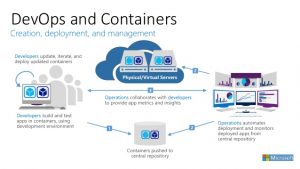Containers are regarded as a key component in DevOps. But, what makes them such an important ingredient? How does it relate to the DevOps methodology? And, how do businesses benefit from them? I have tried answering all these questions in this blog.
Containerization is a resource efficient method that packages stand-alone, executable building blocks of software into that includes code, runtime, system tools, system libraries and settings. This provides consistency, efficiency, productivity and version control.
DevOps, on the other hand, is a set of best practices and processes to improve your software development. It emphasizes on a culture of collaboration among all parts of the Dev and IT in your organization and the “continuous delivery” of software.
Containers are the answer to the question of how to get a software run effectively when shifted from one computing environment to another. From a developer’s machine to a testing environment, from a testing phase into production or maybe from a physical machine on to a VM. The entire runtime environment which include the application, its dependencies, libraries and configuration files that are needed to run it are all packed together in a container. Containerizing them fades away the differences in OS distributions and infrastructure.
Source: Process flow suggested by Microsoft when containers are introduced into Dev and IT Ops.
Why Containers?
The Agility, Adaptability, and Robustness
Light weight: Containers that run on a single machine share its operating system kernel. Hence, they start instantly and use less RAM.
Compatible: Containers can be run on all major Linux distributions, MS Windows and virtual machines.
Secure: Docker containers provide a robust isolation to limit app issues in a single container instead of the entire machine. They achieve this by isolating applications from one another and from the underlying infrastructure.
Several key benefits offered by Containers that help to fortify DevOps workflows. Some of those benefits are:
Consistency in development, testing and production environments: Writing, testing and deploying applications inside containers maintains a stable environment that doesn’t change at different parts of the delivery chain. The same containerized environment in which they work in makes collaboration between different teams easier (Developers, Admins and Testers).
Continuous updates: Applications are to be updated in a constant and streamlined way. This is essential to continuously deliver software. Using containers, it is easy to apply updates to applications. Different parts of the app distributed into multiple micro services and hosted in different containers can be updated by restarting the container alone. This avoids hampering the rest of the containers.
Agility among frameworks: Agility to switch easily between various frameworks or deployment platforms is preferable while working on DevOps, and Containers help in that. They are Agile. Almost all type of apps can be run inside a container regardless of the language it is written in. They can be moved quickly and easily between different types of host systems. However, containerized apps can’t be moved from a Linux to a Windows server, or vice versa, because of the differences in Docker in those systems.
Control: DevOps with Containerization gives a control on costs. It utilizes available resources in a very effective way while minimizing security risks in parallel.
Comprehensibly, usage of Containers in DevOps workflows is rising tremendously due to the benefits it brings to the table right from the developmental stage till finishing, and to the organization as a whole. Using apt techniques and applying expertise’s methodologies in processes gives an edge over others in every stage of development and delivery.
Check out the casestudy here Docker Implementation on AWS Cloud for ICT Solution Supplier Client.
- Choosing the Right DevOps tool for a Successful Continuous Delivery and Automation | Part 3 - February 27, 2019
- Choosing the Right DevOps tool for a Successful Continuous Delivery and Automation | Part-2 - January 18, 2019
- Choosing the Right DevOps tool for a Successful CI/CD and Automation –Benefits and Disadvantages - January 4, 2019








Comments